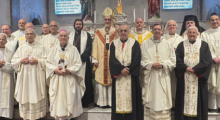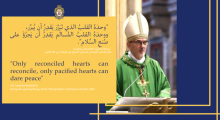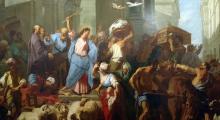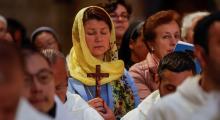Issued by the Catholic Center for Studies and Media - Jordan. Editor-in-chief Fr. Rif'at Bader - موقع أبونا abouna.org
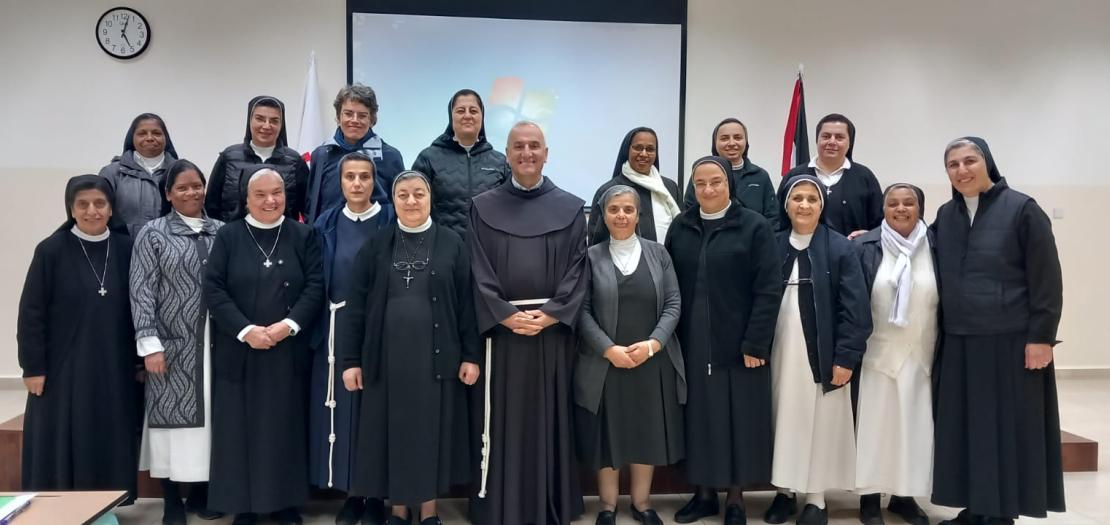
The conclusive event of “LUXTENEBRA, centenary of the Basilicas of Tabor and Gethsemane” was held on 22 November at St Saviour’s convent in Jerusalem. An exhibition of archive documents, period photographs and artistic sketches which tell the story of how the two shrines were built was held in the Mother-of-Pearl Room.A musical concert offered by the youngsters of the Magnificat Institute of Jerusalem followed the closing of the exhibition. The event was possible thanks to the contribution of the Terra Sancta Museum, the archive of the Custody of the Holy Land and St Savior’s Convent, represented by the Guardian, Fra Rodrigo Machado.
LUXTENEBRA, a year full of events
This exhibition officially marks the end of the celebrations for the centenary of the Basilicas of Tabor and Gethsemane. It has been a year dedicated to rediscovering and exploring in depth the meaning and the beauty of the two basilicas, one hundred years after they were built by the Italian architect Antonio Barluzzi.
Among the various events of the centenary we can recall the inauguration of the two permanent exhibitions at the Basilica of Mount Tabor and Gethsemane, the day of lectures on different subjects linked to archaeology and history, art and restoration, philosophic interpretation and the figures related to the churches being celebrated. Lastly, in August 2024 LUXTENEBRA went to Rimini (Italy) for the “Meeting for friendship between peoples.”
Documents and art tell the story of the Basilicas
For the end of this centenary, objects linked to the two jubilee basilicas were on display, many of which could be seen by the public for the first time. Fra Narciso Klimas, Director of the Custody Archive and a member of the scientific committee for the centenary, emphasized that these objects included ancient firmans dating back to the Ottoman period. These historical documents established that the Custody of the Holy Land owned the ground where the two basilicas stand and the possibility for the Franciscan friars to “possess and live and perform their functions and celebrate the Divine Offices and Masses, as they did in the past with the devout pilgrims.”
Tabor and Gethsemane, a message of unity
The event was attended by a number of diplomatic figures from the countries which 100 years ago contributed to building the basilicas. Their participation is very meaningful, Vincenzo Zuppardo, architect and curator of the centenary recalled, stating: “The church of Gethsemane is better known as “the Church of All the Nations” because it was built with contributions from all over the world: nations that had been fiercely fighting one another a couple of years earlier united to contribute to something beautiful that would have contributed in some way to a new model of beauty.”
The title of the centenary, “LUXTENEBRA” , refers to Barluzzi’s conception of architecture, in particular sacred architecture.
“Barluzzi believed,” Vincenzo continues, “that the design of a shrine should reflect the spiritual meaning of the site and the mystery of the life of Christ commemorated there. This vision deeply shaped the designs for the Basilicas concentrating on the mysteries of the Transfiguration and of the Agony. Barluzzi found the perfect architectonic material to express these two mysteries: light, which in these churches goes well beyond its functional role and takes on a very important symbolic value. This is why we chose this title for the centenary."
Contemplating the mystery: an invitation to hope
At a time in history marked by war and suffering, especially in the Holy Land, the mysteries celebrated in the two jubilee basilicas take on a meaning that is more topical than ever. At the end of his speech, Fra Alessandro Coniglio, director of the scientific committee for the Centenary, wanted to recall this aspect.
“Contemplating the interplay of light and darkness in the life of Jesus of Nazareth could be a reminder for us as well that our dark times, with all its violence, has already been taken on by Jesus Christ. We can hope to walk in the light of his victory over death and sin, because he defeated all violence in his death and resurrection. Therefore, we are confident that this final celebration of LUXTENEBRA will also bring light and hope in these difficult times, pointing to the leading figure of these events, which is not the anniversary of a building, but the living mystery of Jesus Christ, of whom those basilicas are still witnesses.”



